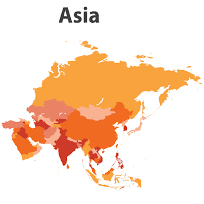Just when markets thought they’d priced in the worst, President Trump’s long-threatened tariff announcement detonated with far more force than anticipated. The scale and severity of the new trade tariffs—now officially underway—have triggered a sharp, visceral response across global markets. Investors are now weighing the fallout as the spectre of recession edges closer and volatility surges to the fore.
Caution proved warranted ahead of President Trump’s so-called Liberation Day, but few anticipated the extreme breadth and intensity of the tariff package now in force. Not only did the measures surpass even the gloomiest forecasts, but the methodology behind them appeared dangerously capricious. The result was a brutal three-day market reaction that erased between 10% and 15% across major indices. This was more than a correction—it was a clear indictment of investor sentiment toward the Trump administration’s trade posture.
Markets are no longer just pricing tariffs—they are recalibrating expectations for global growth and inflation. The immediate concern is how consumer and business confidence will weather this shock. Investors are already factoring in slower global demand, with the odds of a US recession now narrowly in favour. Much hinges on whether other countries respond with restraint or choose their own retaliatory paths, risking a deeper and more entrenched trade war.
President Trump claims fifty countries are ready to negotiate, a potential silver lining amid the storm. However, his continued posturing on maintaining hard-line reciprocal tariffs clouds that hope. The suggestion that these tariffs may remain in place longer than initially expected has dashed optimism for a quick resolution. Still, as bilateral agreements start forming, some effective rates may begin to fall. Yet for now, many countries face what amounts to an economic blockade, with confidence among trade partners already eroding.
Political and public pressure is expected to intensify in the coming days. Business leaders, prominent individuals and global protests will grow louder in urging the US administration to soften its stance. However, if history is any guide, Trump’s unpredictability remains the only constant. Investors can’t count on public sentiment to shift the White House’s course—at least not yet.
Market performance tells the story in stark numbers. The tech-heavy NASDAQ has plunged over 20% since its February peak, marking a descent into official bear market territory. The broader S&P500 has declined by 15% and is on a similar path. The steepest declines are visible in sectors most exposed to global trade: tech giants, logistics, and supply-chain-dependent brands like Nike, Adidas and Apple have all suffered outsized losses.
Meanwhile, the oil market—reacting to both reduced demand forecasts and expanded output from exporting nations—has seen Brent crude tumble towards $60, a sharp drop from its previous $80 highs. This decline offers some economic relief at the consumer level, potentially softening the inflationary blow through lower fuel costs.
Not all areas have seen devastation. Investors seeking shelter have rotated heavily into safe havens. Gold, for instance, is trading near historic highs, reaffirming its status as a crisis hedge. Defensive equity sectors including Health, Telecoms, and Utilities have remained resilient. Fixed income markets have also attracted significant flows, with demand for government and high-quality corporate bonds surging. This shift has driven yields lower, reflecting a widespread expectation that the Federal Reserve will intervene with as many as five rate cuts this year to stem the economic fallout.
Upcoming data on US inflation and consumer confidence may generate temporary headlines, but markets remain fixated on Trump’s tariff agenda. Until a shift in tone or policy emerges from the White House, volatility is here to stay.
TEAM plc (LON:TEAM) is building a new wealth, asset management and complementary financial services group. With a focus on the UK, Crown Dependencies and International Finance Centres, the strategy is to build local businesses of scale around TEAM’s core skill of providing investment management services.











































